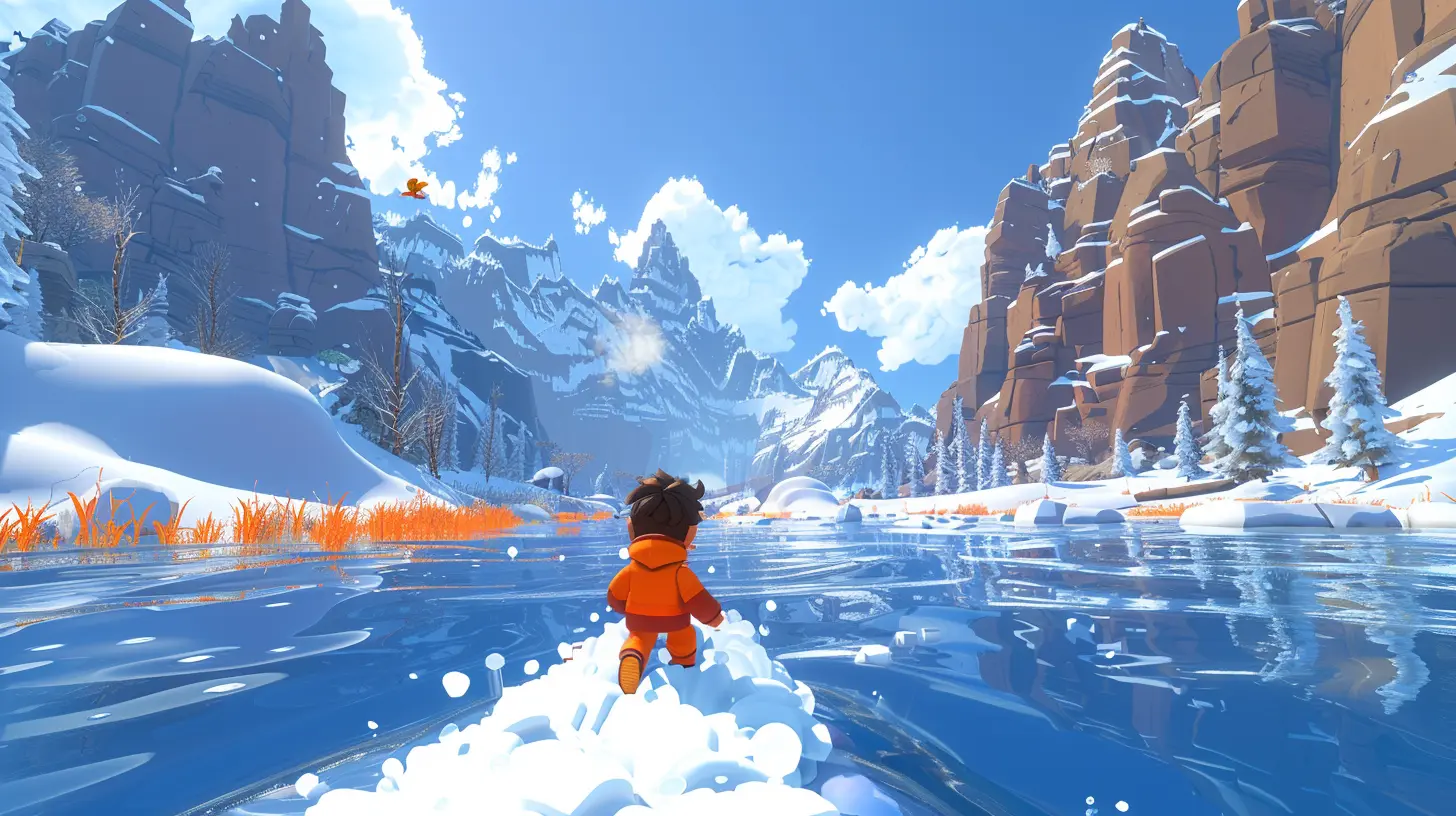Platforming on Ice: Handling Slippery Movement Mechanics
22 May 2025
If you've ever found yourself slipping and sliding through the frosty terrains of a video game, you know the frustration—and occasional hilarity—that slippery movement mechanics can bring. It’s the digital equivalent of trying to walk on actual ice with socks on—awkward, unpredictable, and downright challenging. But that’s part of the fun, isn’t it? These mechanics aren’t just a gimmick; they can shape how a game feels, how it plays, and how you, the player, adapt to its quirks.
In this article, we’re going to take a deep dive into the frosty world of "platforming on ice." We’ll figure out why developers use slippery mechanics, how they impact gameplay, and what it takes to master those frustratingly fun (or funnily frustrating?) icy sections. So, grab your virtual snow boots, and let’s glide into the topic.
What Are Slippery Movement Mechanics?
Slippery movement mechanics, in the simplest terms, simulate the lack of friction. When a player steps onto an ice-covered surface in a game, their character doesn’t stop when they let go of the controls. Instead, they keep sliding, as if the ice has turned their shoes into greased-up banana peels. It’s physics—well, video game physics anyway.But why do developers include these mechanics? For one, it’s about variety. Ice-covered levels or sections break up the regular gameplay pacing. They introduce a new challenge—one that forces players to think differently. Instead of running, stopping, and jumping on a dime, you’re now dealing with momentum. Suddenly, every movement feels like you’re trying to drive a car on bald tires during a snowstorm. Fun, right? (Okay, maybe "fun" isn’t your first thought, but stay with me.)
The Psychology of Slippery Platforms
Let’s be honest for a second: slippery mechanics can make people rage-quit. "Why would they add this to the game?" you might ask, moments after failing the same jump for the 15th time. But games are supposed to challenge us, and slippery levels are a perfect way to spice things up without fundamentally changing a game’s core mechanics.Think about it—these moments test your patience, timing, and adaptability. They’re frustrating, sure, but they’re also rewarding. There’s nothing quite like the feeling of finally nailing that impossible jump because you timed your slide just right. That victory is all the sweeter because the struggle made it worth it.
Game developers know this. That’s why ice levels have become a staple of platformers, dating all the way back to the golden age of gaming. It’s a love-hate relationship, and every gamer has at least one slippery-level war story that scars them to this day.
Iconic Examples of Ice Levels in Gaming
Ah, ice levels. They’ve been around forever, and they’re not going anywhere. Let’s take a quick trip down memory lane and look at some of the most iconic icy challenges in gaming:1. Super Mario Bros. 3 – Ice Land
This is where many of us first encountered slippery movement mechanics. In Ice Land, Mario slips, slides, and skids across frozen platforms, making even the simplest jumps a high-stakes affair. Combine slippery surfaces with enemies, and you’ve got yourself a recipe for controller-throwing moments.2. Donkey Kong Country – Gorilla Glacier
Remember how tough Donkey Kong Country was? Now imagine it with ice physics. Gorilla Glacier isn’t just slippery—it’s brutal. Between icy hills and tricky jumps, this level will test your platforming skills like few others.3. The Legend of Zelda: Ocarina of Time – Ice Cavern
While not strictly a platformer, the Ice Cavern section throws icy puzzles and slippery movement into Link’s path. It’s a great example of how slippery mechanics can be used to slow down combat and exploration, forcing players to approach challenges more carefully.4. Celeste – The Mirror Temple
Celeste is already a challenging platformer, but when you add icy surfaces into the mix? It’s a whole new ball game. The game’s precision-based controls make slippery mechanics feel fair, but that doesn’t mean they’re easy to master.5. Crash Bandicoot Series – Snow Go
If you’ve played any Crash Bandicoot game, you’ll know that ice levels don’t mess around. One second you’re confidently bounding through the level; the next, you’re sliding uncontrollably into a pit. Classic Crash chaos.
What Makes Slippery Mechanics So Hard?
So, what’s the deal? Why are slippery mechanics so headache-inducing? It all boils down to one word: momentum.When you’re playing a platformer, you’re used to a certain type of control. You press left or right, and your character responds instantly. But icy surfaces change the rules. Now, your character doesn’t stop when you stop pressing the button. They keep sliding, like they’re auditioning for a figure skating show. This forces you to account for movement after the fact.
To make matters worse, many games pile on additional hazards—like moving platforms, enemies, or bottomless pits—all while you’re trying to manage your slippery footing. It’s like being asked to juggle while riding a unicycle on a sheet of ice. Easy, right?
Mastering Slippery Movement Mechanics
Alright, let’s talk strategy. How do you stop slip-sliding your way to failure? Here are a few tips to help you conquer those pesky ice levels:1. Plan Your Movements in Advance
Slippery surfaces punish impulsiveness. Instead of reacting in the moment, pause and think about your next move. Treat every jump and slide like a mini-chess game.2. Tap, Don’t Hold
If you’re used to holding down movement buttons, resist the urge. Short, controlled taps can help you adjust your momentum without overshooting your target.3. Use Momentum to Your Advantage
Instead of fighting the slide, embrace it. Let the momentum carry you where you need to go, and focus on timing your jumps and adjustments.4. Practice Precision
Slippery mechanics are all about small, precise movements. This isn’t the time to mash buttons—stay calm, steady, and deliberate.5. Patience is Key
Let’s be real: you’re going to fail a lot before you succeed. That’s just the nature of ice levels. Take a deep breath, laugh at your mistakes, and keep trying. Rome wasn’t built in a day, and no one masters icy platforms in one attempt.A Look at Game Design: Why Developers Love Ice Levels
From a design perspective, slippery mechanics are brilliant. They’re a simple way to add depth and variety without introducing entirely new systems. Developers can use the same moves, enemies, and puzzles, but the shift in physics makes everything feel fresh.Ice levels also build tension. That feeling of "I’m barely in control, but I think I can do this" is thrilling. It’s the gaming equivalent of gripping the edge of your seat during an action movie. And when you finally succeed? Pure satisfaction.
Why Gamers Love (and Hate) Ice Levels
Let’s be honest—most of us hate ice levels when we’re in the thick of them. They’re frustrating, slippery, and make us question our gaming skills. But looking back? There’s a weird fondness for them. They’re memorable. They stand out.Years later, you’re not going to reminisce about the level where everything was easy. You’re going to remember the one where the floor felt like butter, your character wouldn’t stop sliding, and you somehow managed to stick the landing after an impossible jump. That’s the magic of slippery mechanics—they leave an impression.
Final Thoughts
Platforming on ice is a love-it-or-hate-it affair, but it’s undeniably a core part of gaming history. Slippery movement mechanics challenge us to rethink how we play, and they prove just how creative game design can be. Whether you’re sliding through Ice Land in Super Mario Bros. 3 or braving the frosty puzzles of The Legend of Zelda, one thing’s for sure—they leave us with stories worth sharing.So the next time you find yourself cursing an ice level, take a step back and appreciate it for what it is: a test of adaptability, skill, and patience. And hey, if all else fails, at least it makes for a good laugh.
all images in this post were generated using AI tools
Category:
Platformer GamesAuthor:

Tina Fisher
Discussion
rate this article
3 comments
Lacey Patel
This article effectively explores how slippery mechanics enhance challenge and strategy, enriching the overall platforming experience.
June 2, 2025 at 5:04 AM

Tina Fisher
Thank you! I'm glad you found the exploration of slippery mechanics engaging and appreciate their impact on strategy in platforming.
Rosanna McCaffrey
Great read! Slippery mechanics can make or break a platformer, adding a unique challenge that tests player skill. It’s fascinating how developers balance frustration and fun. I appreciate the tips on mastering control—definitely helps when facing those icy obstacles! Looking forward to more insights!
May 24, 2025 at 5:00 AM

Tina Fisher
Thank you for your feedback! I'm glad you found the tips helpful. Balancing challenge and enjoyment is key in platformers, especially with slippery mechanics. Stay tuned for more insights!
Echo Holland
Great insights on slippery movement mechanics! It's fascinating how they can add both challenge and charm to platforming games. Looking forward to seeing more innovative designs in this space!
May 23, 2025 at 2:25 AM

Tina Fisher
Thank you! I'm glad you enjoyed the insights. Exciting times ahead for platforming mechanics!



